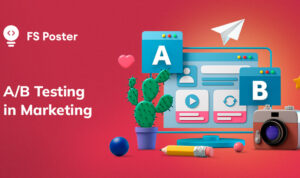A/B Testing in Marketing opens doors to revolutionary strategies that can transform the way businesses reach their audience. Brace yourself for a journey filled with data-driven decisions and game-changing insights.
Exploring the depths of A/B testing reveals the hidden gems of marketing experimentation and optimization, paving the way for unprecedented growth and success.
Introduction to A/B Testing in Marketing
A/B testing, also known as split testing, is a method used in marketing to compare two versions of a webpage, email, or other marketing assets to determine which one performs better. This is done by showing the two versions, A and B, to similar audiences and analyzing which one yields better results in terms of conversions, click-through rates, or other key performance indicators.
A/B testing is crucial in marketing campaigns as it allows marketers to make data-driven decisions rather than relying on assumptions or gut feelings. By testing different variations, marketers can understand what resonates best with their audience and optimize their campaigns for better results. This ultimately leads to improved ROI and a more effective marketing strategy.
Importance of A/B Testing in Marketing
- A/B testing helps in identifying the most effective elements of a marketing campaign, such as headlines, call-to-action buttons, or images.
- It provides insights into customer preferences and behavior, allowing marketers to tailor their messaging accordingly.
- By continuously testing and optimizing, marketers can ensure that their campaigns are always performing at their best.
Examples of A/B Testing Impact on Marketing Strategies
- Company A tested two different versions of their landing page, one with a green button and the other with a red button. Through A/B testing, they discovered that the red button resulted in a 20% increase in conversions.
- An email marketing campaign for Company B tested two subject lines, one straightforward and the other more creative. The A/B test showed that the creative subject line had a higher open rate, leading to more engagement with the email content.
- Company C ran an A/B test on their pricing page, testing different pricing structures. They found that a tiered pricing model resulted in higher average order values and increased revenue.
Setting Up A/B Tests: A/B Testing In Marketing
When setting up an A/B test in marketing, there are several important steps to follow to ensure accurate results and meaningful insights. The process involves careful planning, execution, and analysis to optimize the effectiveness of the test.
Determining Variables to Test
When selecting variables to test in A/B testing, it is crucial to focus on elements that directly impact the desired outcome. This could include changes in headlines, call-to-action buttons, images, colors, or layout. By isolating specific variables, you can accurately measure the impact of each change on user behavior and conversion rates.
- Identify the goals of the test and the key metrics to measure.
- Choose variables that are relevant to the goals and have a potential impact on user behavior.
- Avoid testing too many variables at once to maintain clarity and accuracy in the results.
Determining Sample Sizes
Determining the sample sizes for A/B testing is essential to ensure statistical significance and reliability of the results. The size of the sample group can impact the validity of the test and the ability to draw meaningful conclusions.
Sample sizes should be large enough to detect meaningful differences between the control group and the variant group.
- Calculate the required sample size based on the desired level of confidence and statistical power.
- Consider factors such as the expected effect size and variability in user behavior when determining sample sizes.
- Use online calculators or statistical software to determine the appropriate sample size for your A/B test.
Types of A/B Tests

When it comes to A/B testing in marketing, there are different types of tests that can be conducted to optimize campaigns and improve results. Let’s explore some of the common types of A/B tests used in the industry.
Content Testing
Content testing involves testing different variations of content elements such as headlines, copy, images, and call-to-action buttons to see which combination resonates best with the target audience. By analyzing the performance of each variation, marketers can determine the most effective content for driving conversions.
- Example: A company decides to A/B test two different headlines for their email marketing campaign to see which one generates a higher open rate.
- Example: An e-commerce website tests two different product images to determine which one leads to more purchases.
Pricing Testing
Pricing testing involves testing different price points for products or services to identify the optimal pricing strategy that maximizes revenue and profit margins. By comparing how different price points impact customer behavior, marketers can make data-driven decisions to set the right prices.
- Example: An online subscription service tests two pricing plans to see which one attracts more customers and generates higher revenue.
- Example: A retail store tests different discount offers to determine which one drives more sales without sacrificing profit margins.
Layout Testing
Layout testing focuses on testing different layouts and designs of web pages, landing pages, and emails to evaluate how the placement of elements impacts user engagement and conversions. By experimenting with various layouts, marketers can optimize the overall user experience and improve conversion rates.
- Example: An e-commerce website tests two different layouts for their product pages to see which one leads to more add-to-cart actions.
- Example: A B2B company tests two different email templates to determine which layout generates a higher click-through rate.
Comparison with Multivariate Testing
While A/B testing involves testing two variations of a single element, multivariate testing allows marketers to test multiple variations of multiple elements simultaneously. A/B testing is ideal for comparing two distinct options, while multivariate testing is suitable for analyzing the combined impact of multiple variables on user behavior.
Analyzing A/B Test Results
When it comes to analyzing A/B test results, it is crucial to do so accurately in order to draw meaningful conclusions that can inform future marketing strategies. By understanding how to interpret the data correctly and being aware of common pitfalls to avoid, marketers can make informed decisions based on the test outcomes.
Interpreting A/B Test Results
- Compare key metrics: Look at metrics such as conversion rates, click-through rates, or revenue to determine which variation performed better.
- Statistical significance: Ensure that the results are statistically significant before making conclusions. Use tools like p-values and confidence intervals to determine if the differences are due to chance.
- Segmentation analysis: Dive deeper into the data by segmenting results based on different user characteristics. This can provide insights into how different groups responded to the variations.
Common Pitfalls to Avoid
- Early conclusions: Avoid jumping to conclusions too quickly before the test has reached statistical significance. Patience is key in A/B testing.
- Ignoring secondary metrics: While focusing on primary metrics is important, don’t overlook secondary metrics that could provide valuable insights into user behavior.
- Overlooking long-term impact: Consider the long-term effects of the variations on user behavior, as short-term results may not always reflect the full impact.
Best Practices for Drawing Conclusions
- Document the process: Keep track of the test setup, hypotheses, and results to ensure transparency and reproducibility.
- Iterate and learn: Use A/B testing as a learning opportunity to continuously improve marketing strategies based on data-driven insights.
- Collaborate with stakeholders: Involve key stakeholders in the analysis process to gain different perspectives and ensure alignment on next steps.
Implementing Changes Based on A/B Test Results

Implementing changes based on A/B test results is crucial for optimizing marketing strategies and improving overall performance. Once you have analyzed the data and identified the winning variation, it’s time to take action and make the necessary adjustments to your campaigns.
Scaling Successful A/B Test Variations
When scaling successful A/B test variations, it’s important to consider the following strategies:
- Gradual Implementation: Start by rolling out the winning variation to a small segment of your audience before making it live for the entire target group. This allows you to monitor performance and make any additional tweaks if needed.
- Consistency: Ensure that the changes implemented are consistent across all marketing channels to maintain a cohesive brand message and user experience.
- Data-Driven Decisions: Continuously track and analyze the performance of the winning variation to validate its success and make informed decisions for future optimizations.
- Iterative Testing: Use the insights gained from successful A/B tests to inform future experiments and improvements, creating a cycle of continual optimization.
Real-Life Examples of Companies Benefiting from A/B Test Implementations
Amazon:
Amazon famously uses A/B testing extensively to optimize its website layout, product recommendations, and pricing strategies. By testing different variations, Amazon has been able to increase conversion rates and drive higher revenue.
Netflix:
Netflix utilizes A/B testing to personalize content recommendations for its users, improving user engagement and retention. By testing different algorithms and features, Netflix has been able to enhance the overall user experience on its platform.
Uber:
Uber has leveraged A/B testing to refine its app interface, pricing models, and promotional strategies. Through data-driven experiments, Uber has successfully optimized its services and increased customer satisfaction.
These examples highlight the importance of implementing changes based on A/B test results and the significant impact it can have on a company’s marketing performance.
Tools and Software for A/B Testing
When it comes to A/B testing in marketing, having the right tools and software is crucial for accurate testing and analysis of results. There are several popular tools available in the market, each offering unique features and capabilities. Let’s take a look at some of the top A/B testing tools and compare their features to help you choose the right one for your business.
Popular A/B Testing Tools, A/B Testing in Marketing
- Optimizely: Known for its user-friendly interface and robust testing features, Optimizely allows users to create and run A/B tests without the need for coding skills. It also offers advanced targeting options and real-time results tracking.
- Google Optimize: Integrated with Google Analytics, Google Optimize is a powerful tool that provides in-depth insights into user behavior. It allows for easy setup of A/B tests and personalization campaigns based on user segments.
- VWO: Visual Website Optimizer (VWO) is another popular choice for A/B testing. It offers a drag-and-drop editor for creating test variations, as well as advanced targeting options and heatmaps for analyzing user interactions.
Considerations for Choosing the Right A/B Testing Tool
- Features and Capabilities: Consider the specific features and capabilities offered by each tool, such as ease of use, targeting options, integrations with other platforms, and data analysis capabilities.
- Pricing: Evaluate the cost of each tool and determine whether it fits within your budget. Some tools offer tiered pricing plans based on the level of features and support needed.
- Integrations: Check if the A/B testing tool integrates seamlessly with your existing marketing stack, such as CRM systems, email marketing platforms, and analytics tools, to ensure smooth data flow and analysis.
- Support and Training: Consider the level of customer support and training provided by the tool vendor. Look for resources such as documentation, tutorials, and customer support channels to help you make the most of the tool.


